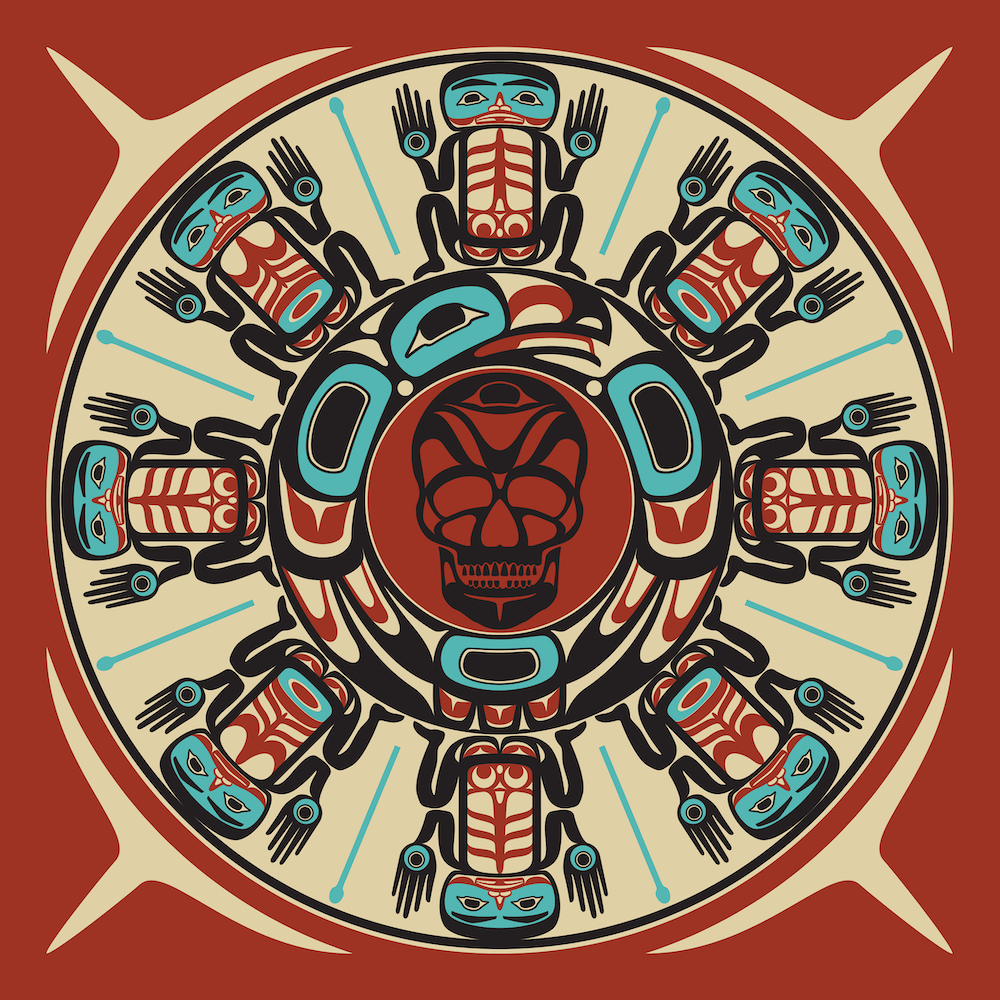


Wow! What a thoughtful, beautifully presented and wonderfully crafted box set! Containing six full concerts from 1973-74, spread over 19 CDs, this is the largest box set I own (I think).
And it really is stunning. The box itself, and all the artwork contained within it, was created by Canadian First Nations artist Roy Vickers and perfectly represents the beauty and soul of the Pacific Northwest, a place whose magnificence has profoundly impressed the Grateful Dead's members ever since they first ventured north in the mid-1960s.
"We were in the Pacific Northwest, between somewhere in Washington and some other where in Oregon," recalled band guitarist Bob Weir in the 65-page book that accompanies this set. "The road took us to the lip on a ridge, from where we could see around us for many miles in all directions … It was breathtaking to behold, but as we watched, we had a firm realization that we were witnessing something even more beautiful than our eyes could ever take in … life causes life. Heaven and Earth dance in this way endlessly, and their child is the forest. And so there we were, epiphanously watching that grandest and most glorious dance of life - of which we are just a tiny part - awed by a magnificence without beginning, without end ..."
I don't know if he smoked a joint before saying all that, but it's a good summation. And it's true.
It can not have been cheap to produce a set such as this and it will almost certainly become a much sought after collector's item in years to come. Only 15,000 copies exist, so if you want one you better act fast.
Pacific Northwest ’73-‘74 (The Complete Recordings) contains six shows in three cities - Vancouver, Portland and Seattle - on two tours over the course of one year. It was a time when the 'Dead were, arguably, at their creative peak. Original keyboardist, Pigpen, was gone, but new recruits Keith and Donna Godchaux blended in nicely. Kieth was far more skilled on the keyboard than Pigpen, which allowed the band the additional freedom to expand their improvisational explorations - and they do that here a lot.
Drummer Mickey Hart is also absent from this collection, having left the group 1971 after his father, who had managed the band for a brief time, got caught embezzling $70,000 from the band. His departure left the band with just one drummer, and while it makes for a much leaner sound it left me wondering how Hart's contribution might have filled things out. On the other hand it's probably a good thing he's not playing on these shows because he was in really rough shape at the time due to a drug dependancy that worsened after his father's betrayal. His playing became sloppy and unfocused. Bill Kreutzmann - the band's "other" drummer - has said it got to the point where it was impossible for him to play with Hart.
So Hart left the band, but he would eventually overcome his addiction and return to the fold in 1974.
The year before these shows was the legendary Europe '72 run, which resulted in an incredible live record (and also a 73-disc box set of all 22 shows) of the same name. It's nice to see the band still full of that same energy and improvisational intuition, the kind of stuff I can listen to all day long.
The Grateful Dead have made a very lucrative second career out of releasing official live recordings of their shows on their own and selling them online. It's remarkable really, since for decades they've allowed fans - encouraged them, even - to record and trade shows among themselves. I remember attending a Grateful Dead concert and walking past the "taper's section" at the back of the hall. Hundreds of microphones held high on really long sticks, all sanctioned by the band.
The official live-shows-for-sale era began in 1993 when the band's original archivist, Dick Latvala, began releasing a series official live recordings under the banner Dick's Picks. These shows were handpicked by Latvala for their integrity and quality, and many of them were highly regarded among collectors who would would swap audience tapes back and forth while dreaming of better sounding, official releases. Titled simply Dick's Picks Volume One, the first official release was a 1973 show from Tampa, Florida. In all, 36 shows under the Dick's Picks moniker were released, some in the years following Latvala's passing in 1999. A second series called Dave's Picks appeared in 2012, and continues still. In addition to these official releases, the band has also been releasing themed boxes such as this one that allow fans to not only experience a single show, but actually get transported back in time. That's what it feels like. You are there, on tour with the 'Dead.
Occasionally, the 'Dead also release shows on vinyl. Those are the ones I really like to scoop up.
A 3-CD package of songs selected from Pacific Northwest ’73-‘74 (The Complete Recordings) called Pacific Northwest '73–'74: Believe It If You Need It, was also released alongside this set. It's basically a highlight reel.
Standouts on this set include a 47-minute (!!) Playing in the Band from the Seattle ’74 gig, which may be a bit much for a casual listener but proves the band could elevate their audience - and themselves - to incredible heights when everything lined up. Garcia's voice is in good shape throughout this collection, as is his playing. He is said to have been exhausted after this run of shows and wanted to get off the road for a while. He certainly earned a break!
I have not yet listened to all 19 CDs, but what I have heard so far has been wonderful. I intend to keep listening, and even though it's going to be hard to come by this box set is …
Wow! What a thoughtful, beautifully presented and wonderfully crafted box set! Containing six full concerts from 1973-74, spread over 19 CDs, this is the largest box set I own (I think).
And it really is stunning. The box itself, and all the artwork contained within it, was created by Canadian First Nations artist Roy Vickers and perfectly represents the beauty and soul of the Pacific Northwest, a place whose magnificence has profoundly impressed the Grateful Dead's members ever since they first ventured north in the mid-1960s.
"We were in the Pacific Northwest, between somewhere in Washington and some other where in Oregon," recalled band guitarist Bob Weir in the 65-page book that accompanies this set. "The road took us to the lip on a ridge, from where we could see around us for many miles in all directions … It was breathtaking to behold, but as we watched, we had a firm realization that we were witnessing something even more beautiful than our eyes could ever take in … life causes life. Heaven and Earth dance in this way endlessly, and their child is the forest. And so there we were, epiphanously watching that grandest and most glorious dance of life - of which we are just a tiny part - awed by a magnificence without beginning, without end ..."
I don't know if he smoked a joint before saying all that, but it's a good summation. And it's true.
It can not have been cheap to produce a set such as this and it will almost certainly become a much sought after collector's item in years to come. Only 15,000 copies exist, so if you want one you better act fast.
Pacific Northwest ’73-‘74 (The Complete Recordings) contains six shows in three cities - Vancouver, Portland and Seattle - on two tours over the course of one year. It was a time when the 'Dead were, arguably, at their creative peak. Original keyboardist, Pigpen, was gone, but new recruits Keith and Donna Godchaux blended in nicely. Kieth was far more skilled on the keyboard than Pigpen, which allowed the band the additional freedom to expand their improvisational explorations - and they do that here a lot.
Drummer Mickey Hart is also absent from this collection, having left the group 1971 after his father, who had managed the band for a brief time, got caught embezzling $70,000 from the band. His departure left the band with just one drummer, and while it makes for a much leaner sound it left me wondering how Hart's contribution might have filled things out. On the other hand it's probably a good thing he's not playing on these shows because he was in really rough shape at the time due to a drug dependancy that worsened after his father's betrayal. His playing became sloppy and unfocused. Bill Kreutzmann - the band's "other" drummer - has said it got to the point where it was impossible for him to play with Hart.
So Hart left the band, but he would eventually overcome his addiction and return to the fold in 1974.
The year before these shows was the legendary Europe '72 run, which resulted in an incredible live record (and also a 73-disc box set of all 22 shows) of the same name. It's nice to see the band still full of that same energy and improvisational intuition, the kind of stuff I can listen to all day long.
The Grateful Dead have made a very lucrative second career out of releasing official live recordings of their shows on their own and selling them online. It's remarkable really, since for decades they've allowed fans - encouraged them, even - to record and trade shows among themselves. I remember attending a Grateful Dead concert and walking past the "taper's section" at the back of the hall. Hundreds of microphones held high on really long sticks, all sanctioned by the band.
The official live-shows-for-sale era began in 1993 when the band's original archivist, Dick Latvala, began releasing a series official live recordings under the banner Dick's Picks. These shows were handpicked by Latvala for their integrity and quality, and many of them were highly regarded among collectors who would would swap audience tapes back and forth while dreaming of better sounding, official releases. Titled simply Dick's Picks Volume One, the first official release was a 1973 show from Tampa, Florida. In all, 36 shows under the Dick's Picks moniker were released, some in the years following Latvala's passing in 1999. A second series called Dave's Picks appeared in 2012, and continues still. In addition to these official releases, the band has also been releasing themed boxes such as this one that allow fans to not only experience a single show, but actually get transported back in time. That's what it feels like. You are there, on tour with the 'Dead.
Occasionally, the 'Dead also release shows on vinyl. Those are the ones I really like to scoop up.
A 3-CD package of songs selected from Pacific Northwest ’73-‘74 (The Complete Recordings) called Pacific Northwest '73–'74: Believe It If You Need It, was also released alongside this set. It's basically a highlight reel.
Standouts on this set include a 47-minute (!!) Playing in the Band from the Seattle ’74 gig, which may be a bit much for a casual listener but proves the band could elevate their audience - and themselves - to incredible heights when everything lined up. Garcia's voice is in good shape throughout this collection, as is his playing. He is said to have been exhausted after this run of shows and wanted to get off the road for a while. He certainly earned a break!
I have not yet listened to all 19 CDs, but what I have heard so far has been wonderful. I intend to keep listening, and even though it's going to be hard to come by this box set is …


